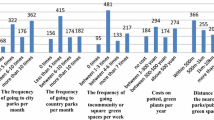Abstract
This study examines the existing podium-tower form of mixed-use residential development in Hong Kong and reveals its effects on street lives and pedestrian movements within high-rise, high-density residential areas. The podiums accommodate shops, facilities, and modes of transportation for those living above and in the surrounding area. The Tuen Mun complex’s well-linked podium spaces illustrate that the podium form maximizes internal uses below residential areas, but segregates the closely located residential space from daily commercial activities. The existing podium spaces privatize streets and plazas for residents in towers and visitors to podium-space commercial shops, not for a layperson exploring there. Although ground-level streets and plazas are public spaces where diverse urban activities occur, podiums’ internal corridors and halls are semipublic areas where designated shopping activities occur. While podiums enhance the convenience and safety of common space, these internal space become less public for internal users and include more barriers such as vertical circulation from the public street. The findings are expected to contribute to public awareness of and consciousness in relation to the development of compact and composite residential environments.




























Similar content being viewed by others
References
Chan, E., Tang, B.S. and Wong, W.S. (2002) Density control and the quality of living space: A case study of private housing development in Hong Kong. Habitat International 26(2): 159–175.
Cho, S.H. and Lee, T.K. (2011) A study on building sustainable communities in high-rise and high-density apartments – focused on living program. Building and Environment 46(7): 1428–1435.
Dong, L. (2008) Organizing an integrated sky street system as an approach to urban mega-structure in Hong Kong, Master of Urban Design thesis, University of Hong Kong, Pokfulam, Hong Kong.
Forrest, R., La Grange, A. and Yip, N.M. (2002) Neighbourhood in a high rise, high density city: some observations on contemporary Hong Kong. Sociological Review 50(2): 215–240.
Guo, Z. and Loo, B.P. (2013) Pedestrian environment and route choice: evidence from New York City and Hong Kong. Journal of Transport Geography 28: 124–136.
Huang, S. (2006) A study of outdoor interactional spaces in high-rise housing. Landscape and Urban Planning 78(3): 193–204.
Hui, E.C.M. and Yu, K.H. (2013) Commuting patterns of residents within a high-density urban development: A study of Hong Kong. Habitat International 39: 201–213.
Hwang, S. (2009) Towards a volumetric city: A critical assessment of Hong Kong’s embryonic conditions towards an efficientmulti-level compact city. Doctor of Philosophy thesis, University of Hong Kong, Pokfulam, Hong Kong.
Lau, S.S.Y., Giridharan, R. and Ganesan, S. (2005) Multiple and intensive land use: case studies in Hong Kong. Habitat International 29(3): 527–546.
Law, S.N.A. (2011) Urban form in achieving sustainable communities: mega-podium versus at-grade development in urban regeneration. Master of Science in Urban Planning thesis, University of Hong Kong, Pokfulam, Hong Kong.
Lee, J. (2011) Quality of life and semipublic spaces in high-rise mixed-use housing complexes in South Korea. Journal of Asian Architecture and Building Engineering 10(1): 149–156.
Ng, S.L. (2005) Subjective residential environment and its implications for quality of life among university students in Hong Kong. Quality-of-Life Research in Chinese, Western and Global Contexts Social Indicators Research Series 25: 467–489.
Parvin, A., Min, A.Y. and Beisi, J. (2008) Effect of visibility on multilevel movement: a study of the high-density compact built environment in Hong Kong. Urban Design International 13(3): 169–181.
Planning Department (2012) Land Utilization in Hong Kong 2012, Planning Department, Hong Kong, http://www.pland.gov.hk/pland_en/info_serv/statistic/landu.html, accessed 8 July 2014.
Rotmeyer, J. (2006) Can elevated pedestrian walkways be sustainable? In: U. Mander, C.A. Brebbia,and E. Tiezzi (eds.) The Sustainable City IV: Urban Regeneration and Sustainability. Southampton: WIT Press, pp. 293–302.
Schoeppe, S. and Braubach, M. (eds.) (2007) Tracking obesity by creating healthy residential environment, World Health Organization. Regional Office for Europe.
Seik, F.T. (2001) Planning and design of tampines, an award-winning high-rise, high-density township in Singapore. Cities 18(1): 33–42.
Shelton, B., Karakiewicz, J. and Kvan, T. (2013) The making of Hong Kong: from vertical to volumetric. New York, NY: Routledge.
Tuen Mun and Yuen Long District Planning Office. (2002) Pamphlets on planning for new territories: Tuen Mun, Planning Department, Hong Kong.
Wang, X. and Lau, S.Y. (2002) Pursuing new urban living environment in the new millennium: Projecting the future of high-rise and high density living in Hong Kong. Generative Art 2002: 19.
Wei, J. (2009) A hypothetical urban design approach for rethinking mega-scale podium redevelopment in Hong Kong: North Point Harbour redevelopment, Master of Urban Design thesis, University of Hong Kong, Pokfulam, Hong Kong.
Xue, C.Q., Zhai, H. and Roberts, J. (2010) An urban island floating on the MTR station: A case study of the West Kowloon development in Hong Kong. Urban Design International 15(4): 191–207.
Yuen, B., Yeh, A., Appold, S.J., Earl, G., Ting, J. and Kwee, L.K. (2006) High-rise living in Singapore public housing. Urban Studies 43(3): 583–600.
Acknowledgements
This paper is supported by a grant from Korea Advanced Institute of Science and Technology (G04150046). Any opinions, findings, conclusions, or recommendation in this paper are those of the authors and do not necessarily reflect the views of Korea Advanced Institute of Science and Technology.
Author information
Authors and Affiliations
Corresponding author
Rights and permissions
About this article
Cite this article
Leung, S.M.S., Kim, T.W. & Kim, Y. Linked podiums affecting street life: A case of Tuen Mun in Hong Kong. Urban Des Int 22, 47–72 (2017). https://doi.org/10.1057/s41289-016-0008-6
Published:
Issue Date:
DOI: https://doi.org/10.1057/s41289-016-0008-6




